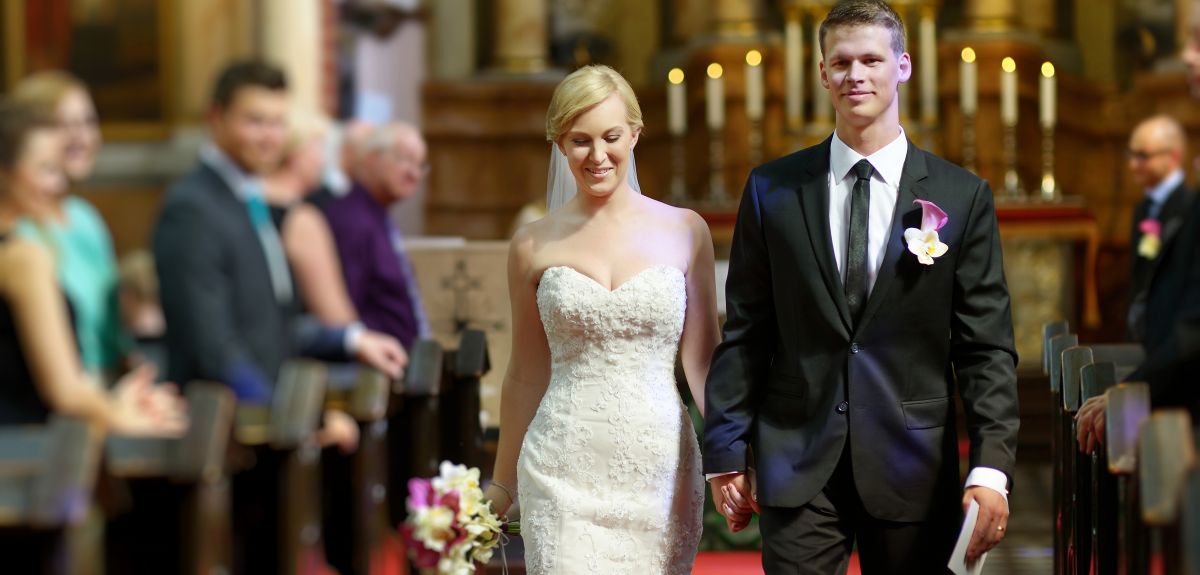
Just one in three weddings in England and Wales has a religious ceremony
Most couples who marry in England or Wales today are choosing a civil ceremony in Approved Premises rather than a Register Office or a religious ceremony.
Oxford University demographer John Haskey has charted the history of marriage since early Victorian times by analysing datasets looking at the manner of solemnisation and denomination in England and Wales. He finds that the rapid rise in marriages in Approved Premises over the past 20 years is one of the fastest changes observed over the last 170 years. Until the Act came into effect, most first marriages for both partners were religious ceremonies. In 2012, however, 70% of all weddings were civil marriages, with 85% of those in Approved Premises, and religious marriages lagged behind at 30% – the smallest proportion recorded since national marriage registration began in 1837. In 2012, 85% of civil marriages were in Approved Premises, such as hotels, castles, stately homes or sports and leisure centres.
The Marriage Act 1994 opened up a wide variety of premises permitted by local authorities for civil marriages. ‘Approved Premises’, included hotels, castles, stately homes or sports and leisure centres. The changes in the Act meant couples were no longer restricted to holding their civil marriage ceremony at a Register Office and also could marry outside their district of residence. Haskey says these two extensions of civil marriage are arguably the most important development in civil marriage since it was first introduced in 1837.
In 1995/96 (covering the first 21 months of the Marriage Act), only 3% of first marriages for both partners were solemnised in Approved Premises, with 60% of first timers opting for religious ceremonies and 36% having Register Office marriages. However, by 2011, 53% of first marriages were in Approved Premises, 37% chose a church wedding and 10% were married in a Register Office.
The research shows that in the past, the previous marital status of the spouses played a major role in where marriages were, or could be, solemnised, and to some extent still does. Until 1996, the trend in the proportion of religious marriages follows almost exactly that of first marriages; and civil marriages those of remarriages involving a divorced partner.
John Haskey, senior researcher at the Department of Social Policy and Intervention, commented: ‘The growth in marriages in Approved Premises has largely been at the expense of religious marriages – and also, to some extent, of Register Office marriages. Although the change in the law allowing couples to marry in Approved Premises quickened the fall in traditional church weddings, the decline had already started in the 1970s – the start of a period of enormous social upheaval. Since then there have been large changes in sexual and partnership behaviour, with rates of divorce, cohabitation, pre-marital cohabitation and births outside marriage all rising considerably. Together with growing secularisation, these factors probably reinforced the trend towards civil marriage.’
Haskey points out that the vast majority of Muslims and Sikhs who marry under English law have a civil marriage, which can be followed by a religious ceremony in their mosque or temple. National data on religious ceremonies conducted after the legal marriage has been solemnised are not collected. At marriage registration, only the faith and denomination in which a marriage is solemnised are recorded, not the religion or denomination of the spouses.
The trends in marriage in the different denominations are also reviewed in Haskey’s study. The proportion of remarriages after divorce is particularly high amongst marriages in the Methodist and United Reformed Churches (as well as in civil marriages), and comparatively low in marriages in the Church of England and Church in Wales.
The research shows that after 1972, the total number of marriages fell, almost entirely due to the decline in religious marriages. From 1976 until 1987 the annual numbers of religious and civil marriages were roughly equal. Since 1987, the number of civil marriages has remained constant, but religious marriages have continued to decline, more than halving between 1987 and 2012.
The proportion of civil marriages rose quickly during the 1960s, and also in the early 1970s, when it was partly fuelled by reforms to the divorce law which allowed divorce on the new basis of separation. During the 1970s, the proportion of all marriages involving a partner who was previously divorced more than doubled from 14% to 31%.
Mr Haskey is one of a group of leading scholars who have contributed to a new book entitled Marriage Rites and Rights, to be published by Hart Publishing in August 2015.
 Expert Comment: Chatbot-driven sexual abuse? The Grok case is just the tip of the iceberg
Expert Comment: Chatbot-driven sexual abuse? The Grok case is just the tip of the iceberg
 New study finds that stopping weight-loss drugs is linked to faster regain than ending diet programmes
New study finds that stopping weight-loss drugs is linked to faster regain than ending diet programmes